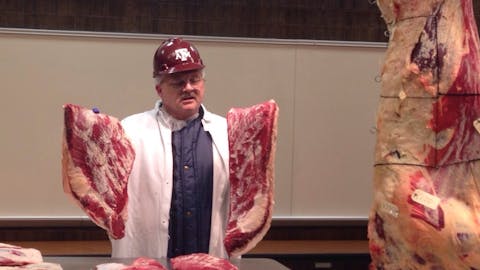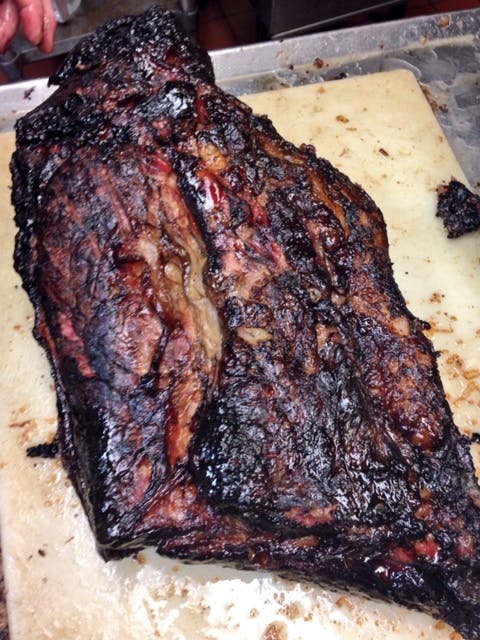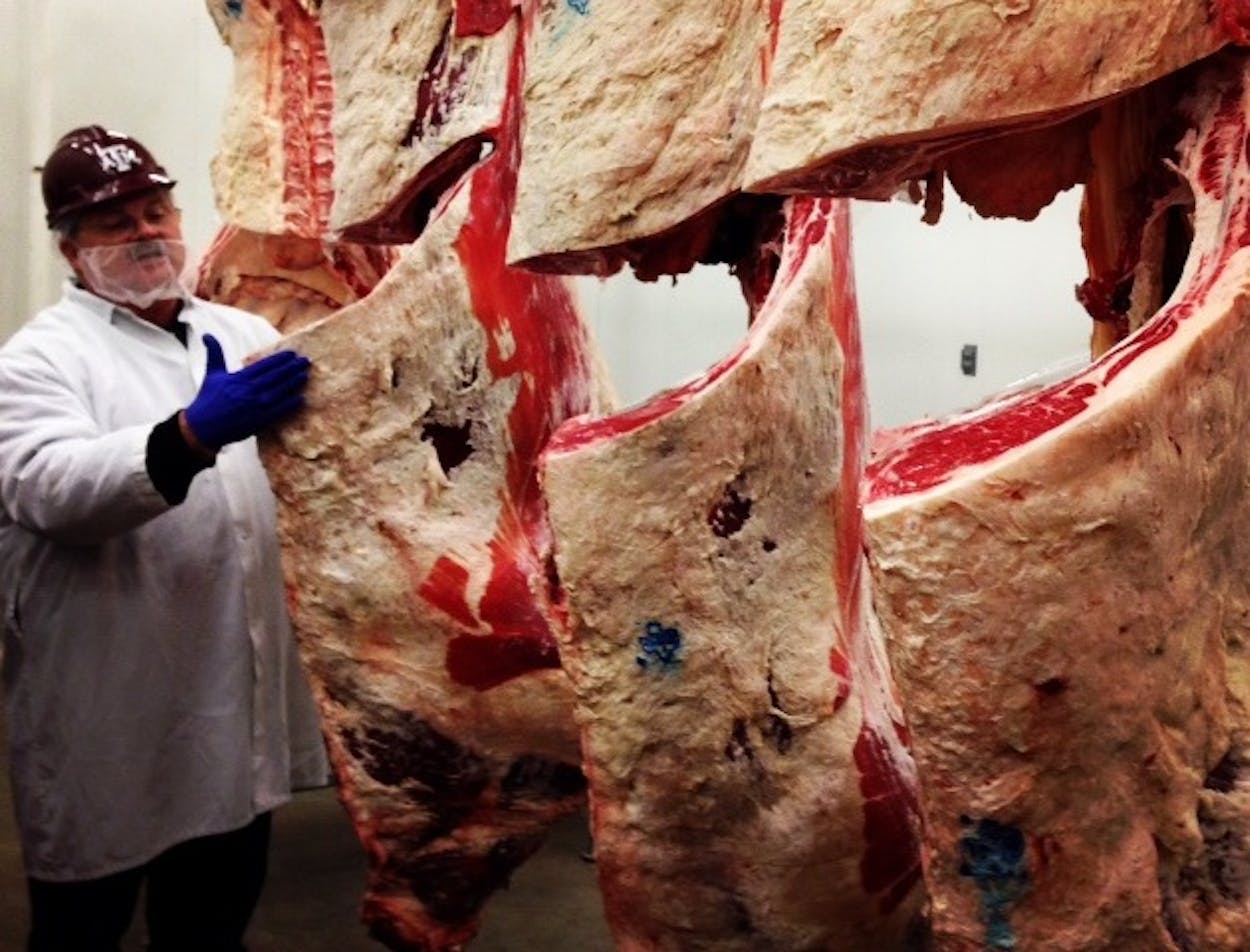That beef is more expensive than it was a year ago is no surprise, and this trend doesn’t look to be easing up anytime soon. As David Anderson, a Texas A&M professor of ag economics, told a room full of barbecue joint owners last month at the university’s first-ever Barbecue Town Hall, retailers should plan on two or three years of elevated pricing.
Of the many slides he presented that illustrated the corn, pork, and beef markets, the one on average wholesale prices of beef showed that numbers steady since mid-July—around $3.00 per pound—up significantly from 2013’s price of $2.20. Brisket is even worse. This past week the price for whole, choice briskets was $3.45 per pound, up from $2.14 a year earlier. On Friday, Urner Barry, a research company that tracks commodity markets, provided some bad news about the immediate future for pitmasters. Brisket prices will continue to rise to record levels.
#brisket prices starting out 2015 at record levels pic.twitter.com/UgOXyAUAs5
— Urner Barry Beef (@UBbeef) January 2, 2015
Stephen Joseph, the owner and pitmaster of Riverport BBQ in Jefferson, Texas, said he’s already seeing the difference. His beef supplier warned him to expect a rise of $0.25 per pound next week so he added a bit more to his order this week trying to stave off the financial affects from his most popular menu item. At the Town Hall, I asked the crowd what other proteins they’ve tried to highlight other than brisket. Russell Roegels of Rogels Barbecue Co. in Houston said “any special we have is anything but beef.” Others pointed to chicken or even pork since prices have gone down recently. Smoked turkey breast is another popular option. It’s primarily sold frozen and has only one predictable seasonal price spike per year.
There’s also not much loss in a lean smoked turkey breast, but let’s face—Texas is a beef state. “We’re all looking for new proteins to serve,” says Wayne Mueller of Louie Mueller Barbecue. “I don’t think we ever want to get out of the beef business, because it’s essential to who we are.”
Just like we got used to high gasoline prices and accepted them as a fact of life, we need not be shocked when brisket prices continue to rise at our favorite barbecue joints. And just like we are now seeing sub-$2.oo gasoline now, those beef prices will go down eventually. The problem is that it just takes so long to get a new crop of cattle. The cattle population has been ravaged by drought, much like the hog population was decimated by PEDv earlier this year, but it takes only eight months for a new litter of piglets to reach slaughter weight (including the gestation period). Calves, however, require about 27 months for the same and are born one at a time. That’s why the folks at Texas A&M are predicting another two or three years of high demand and low supply resulting in the high prices we’re seeing today.
But if demand hasn’t decreased with such high prices, why will the price ever go down for beef? “Producers respond to making money and increase herd sizes,” reminded Anderson, “and producers want to keep the feed lots full.” They just run more efficiently that way. In the meantime, feed lots are trying to keep up with beef demand by producing bigger cattle. Anderson presented data showing a record high dressed weight average that occurred in November of 2014. The average beef carcass then was at 905 pounds, up significantly from 840 pounds last May. That means an average brisket that was twelve pounds will now be thirteen.
Texas A&M’s Dr. Davey Griffin shared an anecdote from a recent beef plant visit. He stood for an hour watching the weights of every carcass that passed. “The lowest we saw in that time was over 900 pounds.” The popular Certified Angus Beef program has responded to the ballooning cattle trend by increasing their maximum allowable carcass weight from 1000 to 1050 in November. As Dr. Jeff Savell of Texas A&M shared with the Town Hall meeting, “probably, for the rest of your life you’ll be dealing with bigger cuts than you’re used to.”
This increase in size is due to several factors including improved genetics, more efficient feeding programs, and growth promoters. In fact, 95 percent of cattle receive a growth promoter like Optiflexx that adds about 20 pounds to a steer. But the big difference these days is the cheap feed. The bulk on cattle comes at the feedlot where they’re fed a corn-heavy diet, and corn is cheap these days so producers are leaving cattle on feed a little longer to get those extra few pounds.

Many barbecue joints have a preference for smaller briskets because they tend to cook more evenly. Beef suppliers are happy to meet their needs as long as there are smaller briskets to provide. As Griffin demonstrated, some beef producers might even cheat on how they cut the briskets to help reduce their size, but those long skinny briskets have a very thin cut edge which results in overcooked, and therefore wasted meat. Barbecue joints will serve themselves better to adapt to the larger briskets coming their way.
Pitmasters could also take some frugality lessons from the past. Our rich history of sausage making in this state was born from scraps, the same scraps that often find their way into the trash in restaurant kitchens. Wayne Mueller credits a trio of homemade sausages for helping to keep his business profitable. Every bit of trim from his briskets and ribs goes into the mix. At Corkscrew BBQ in Spring, Will Buckman puts a pan of trimmings directly into his smoker and uses the smoke-rendered tallow to flavor his beans and other dishes. As Dr. Savell reminded the room, brisket fat has more mono-unsaturated fatty acids than other cuts of beef, making its tallow closer to pork lard in structure. Maybe smoked tallow pie crusts are next.

Another option would be to look at different beef cuts. With the explosion of barbecue’s popularity across the country, brisket will continue to come at a premium. It’s currently up 61 percent from the previous year, but what about other cuts from the forequarter that the old time meat markets used to smoke? A cut like the boneless chuck roll is only up eleven percent over the same time period, and shoulder clod is just 21 percent higher. Depending on your supplier, you might not have to consider different cuts at all. David McLain, a rep from Ben E. Keith, told me via Twitter, “I’d still like to get some people to try 119’s.” These are whole briskets with the deckle still on. McLain continues that those 119’s are “considerably cheaper right now. We have 1600 cases on hand.”
Your move, pitmasters.
- More About:
- Brisket








